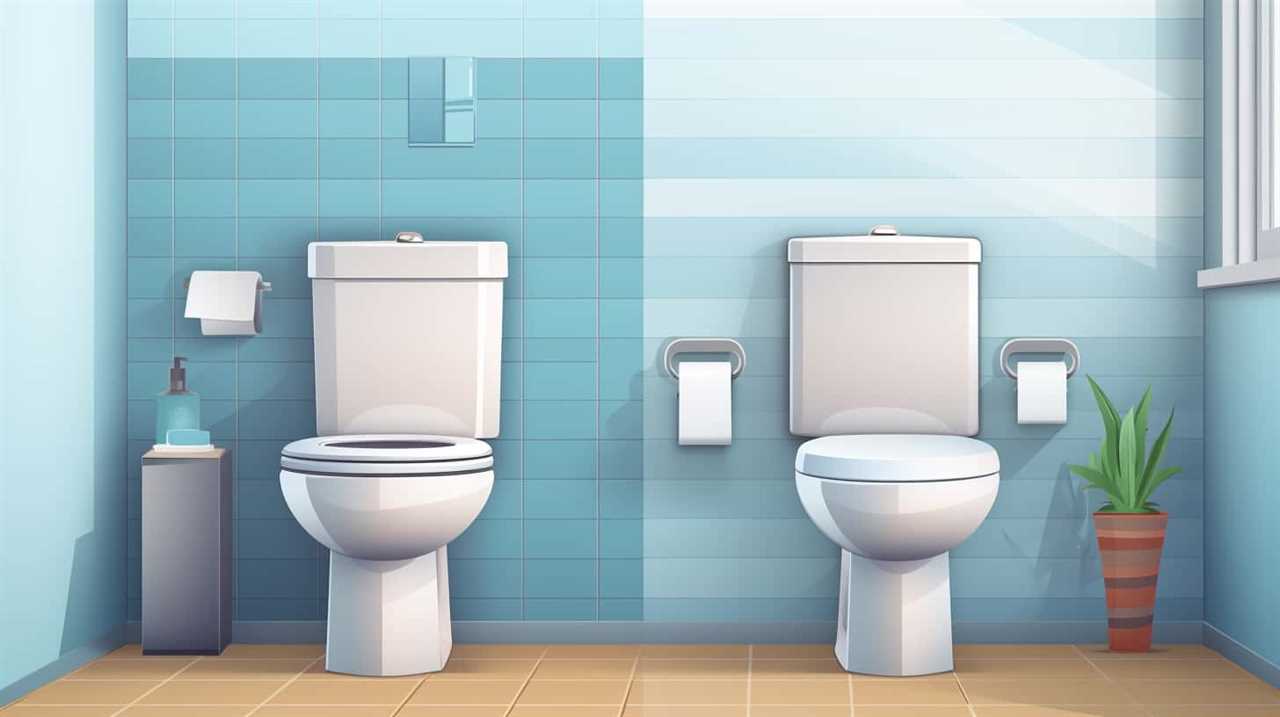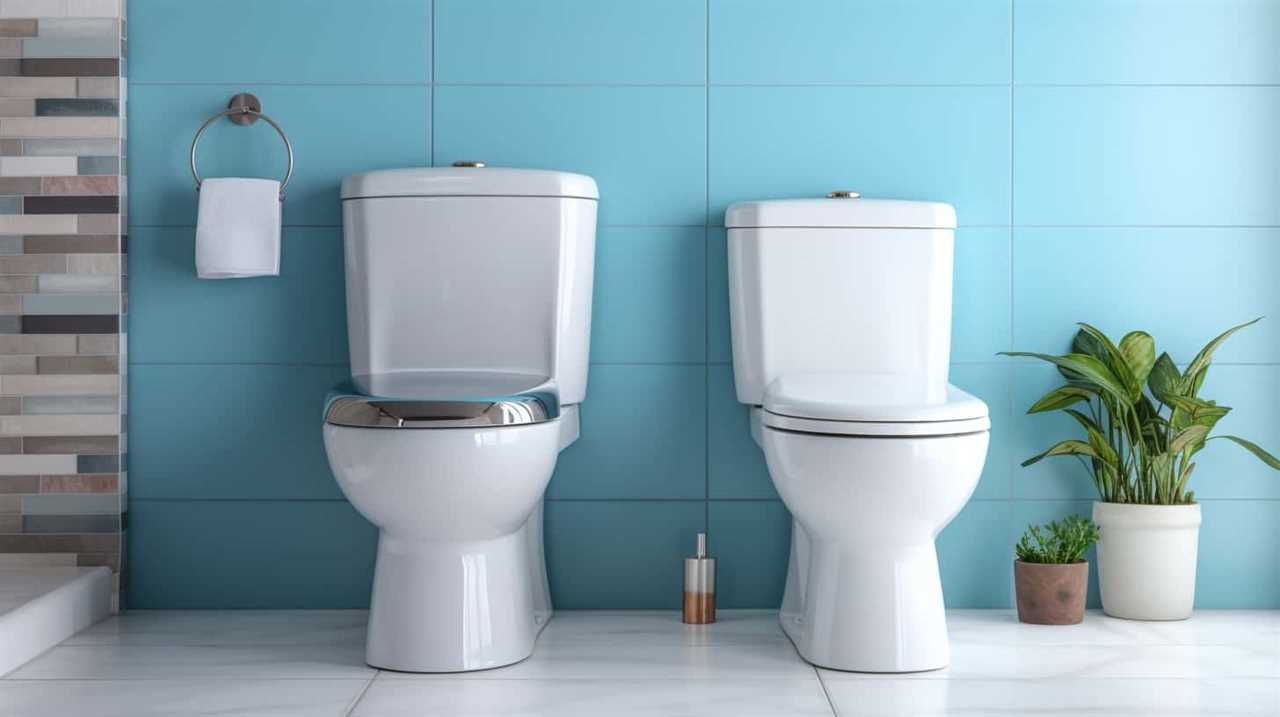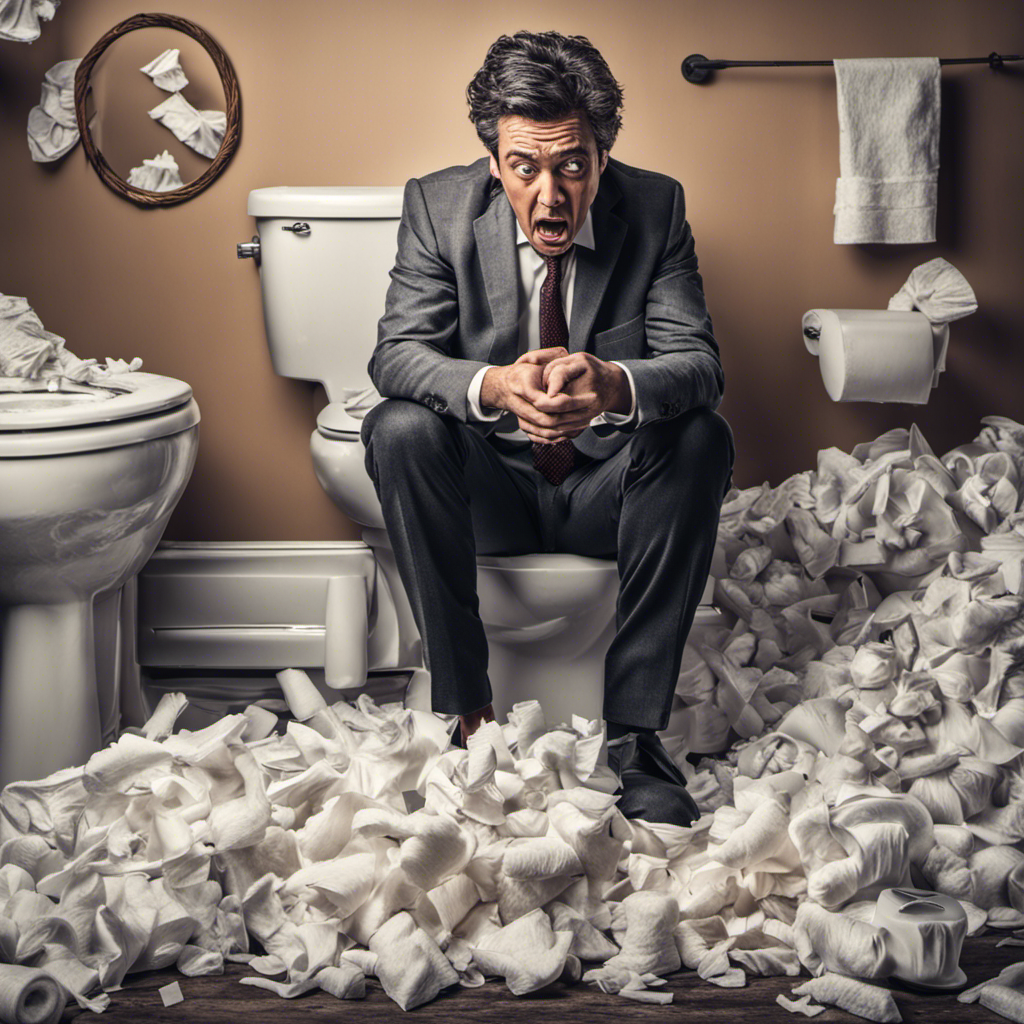Have you ever been curious about the mechanics behind a flushing toilet’s drain? Allow us to shed some light on this for you.
In this article, we will delve into the intricate mechanics of the toilet flush drain, exploring the water flow, gravity’s role, and the components that make it all possible.
From the flapper valve to the trapway, we will guide you through the workings of this essential bathroom fixture.
So, sit back, relax, and prepare to master the art of toilet flush drains.

Key Takeaways
- The toilet flush drain consists of various components such as the flush valve, siphon jet, trapway, and rim jets, which all work together for a successful flush.
- Gravity plays a crucial role in the flushing process, as it pulls water and waste downwards through the drain pipe.
- Pressure dynamics, including the pressure gradient and water displacement, contribute to the efficient removal of wastewater.
- Siphoning action, utilizing atmospheric pressure difference, aids in waste removal and cleanliness but can also lead to potential plumbing issues if not maintained properly.
The Basics of Toilet Flush Drains
Understanding drainage systems is essential for maintaining a properly functioning toilet. We’ll explain the three main components of toilet flush drains.
The first component is the flush valve, which controls the release of water into the toilet bowl. It’s connected to the flush handle and is responsible for initiating the flushing process.
The second component is the siphon jet, located at the bottom of the toilet bowl. It creates a powerful suction that helps remove waste and water from the bowl.
Lastly, we have the trapway, which is a curved pipe that connects the toilet bowl to the waste pipe. This component prevents sewer gases from entering the bathroom.

Regular maintenance, such as checking for leaks and keeping the drain clear of debris, is crucial for ensuring the efficient operation of toilet flush drains.
Understanding the Water Flow
When it comes to understanding the water flow in a toilet flush drain, two key factors come into play: gravity and pressure dynamics.
Gravity ensures that water flows downward, while pressure dynamics regulate the speed and force of the water.
Additionally, the role of siphoning action shouldn’t be overlooked, as it helps to create the necessary suction force that pulls the water and waste out of the toilet bowl.

Gravity and Pressure Dynamics
To understand the water flow in a toilet flush drain, we rely on the interplay between gravity and pressure dynamics. Here’s how it works:
- Pressure gradient: When we flush the toilet, a large volume of water rushes into the bowl. This surge creates a higher pressure at the bottom of the bowl compared to the drain. As a result, the water is pushed downwards towards the drain due to the pressure difference.
- Water displacement: As the water in the bowl moves towards the drain, it displaces the air present in the drain pipe. This displacement creates a vacuum, which further aids in pulling the water down the drain.
- Gravity: Once the water enters the drain, gravity takes over. It pulls the water downwards, allowing it to flow through the drain pipe and eventually out of the toilet system.
Understanding the gravity and pressure dynamics involved in the water flow of a toilet flush drain helps us comprehend how the process works and ensures efficient wastewater removal.
Role of Siphoning Action
The siphoning action plays a crucial role in understanding the water flow of a toilet flush drain. It is a process that utilizes the difference in atmospheric pressure to move liquid from a higher level to a lower level. When you flush a toilet, the siphoning action is initiated, causing the water to flow out of the bowl and into the drain pipe. This action is beneficial as it helps to effectively remove waste and maintain a clean and hygienic environment. However, there are also drawbacks to the siphoning action. It can sometimes create noise during the flushing process, which can be disruptive in certain settings. Additionally, if the siphoning action is not properly maintained or if there are obstructions in the drain pipe, it can lead to clogging and potential plumbing issues.
| Siphoning Action Benefits | Siphoning Action Drawbacks |
|---|---|
| Effectively removes waste | Noise during flushing |
| Maintains cleanliness | Potential for clogging |
| Plumbing issues |
Gravity’s Role in Flushing
As we flush the toilet, gravity swiftly pulls the water and waste down the drain. Gravity plays a crucial role in the flushing process, working in tandem with the design of the toilet to ensure efficient waste removal.

Here’s how gravity contributes to flushing:
- Force of gravity: The weight of the water and waste creates a downward force that pulls everything towards the drain.
- Gravity-assisted flow: The toilet bowl is designed with a curved shape that allows water to flow rapidly, aided by gravity, towards the drain, carrying waste along with it.
- Water conservation: By utilizing gravity to move waste, toilets can operate with minimal water usage. The force of gravity ensures that water and waste are efficiently flushed away, reducing the need for excessive flushing and promoting water conservation.
Understanding the role of gravity in flushing can help us appreciate the importance of proper toilet design for optimal water conservation and flushing efficiency.
Components of a Toilet Flush Drain
Now let’s delve into the components of a toilet flush drain and understand how they contribute to the efficient flushing process.
The toilet flush mechanism consists of several key components that work together to create the necessary water flow dynamics for a successful flush.

First, we’ve the flush valve, which is responsible for releasing water from the tank into the bowl. This valve is typically located at the bottom of the tank and is controlled by a lever or button.
Next, we’ve the siphon jet, which is a small opening in the bottom of the bowl that directs water into the trapway.
The trapway, a curved pipe located beneath the bowl, creates a seal to prevent odors from escaping and allows water and waste to be carried away.
Lastly, we’ve the rim jets, which are small holes around the inside rim of the bowl that release water to create a swirling motion, aiding in the removal of waste.

Together, these components work harmoniously to create a powerful flush and effectively remove waste from the toilet.
The Flapper Valve and Its Function
To understand the function of the flapper valve in the toilet flush drain, let’s explore its role in the flushing process.
The flapper valve is a crucial component that controls the flow of water from the toilet tank to the bowl during a flush. Here is how it works:
- Opening: When the toilet is flushed, the flapper valve mechanism lifts the flapper, allowing water from the tank to rush into the bowl.
- Flushing: The water rapidly fills the bowl, creating enough force to carry away waste and debris.
- Closing: Once the tank is empty, the flapper valve closes, preventing water from continuously flowing into the bowl.
To ensure the proper functioning of the flapper valve, regular maintenance is essential. Over time, the flapper valve may become worn or damaged, leading to leaks and inefficient flushing. Regularly inspecting and cleaning the flapper valve can help prevent these issues and ensure optimal performance.

The Siphon and Its Importance
The siphon plays a crucial role in the efficient functioning of the toilet flush drain. It’s a mechanism that allows water to be drawn out of the tank and into the bowl, creating the necessary force to flush waste down the drain.
The siphon operates on the principle of gravity and pressure differentials. When the toilet is flushed, water is released from the tank, causing the level in the bowl to rise. As the water level rises, it eventually reaches a point where it overflows into the drain.
This creates a pressure differential between the tank and the drain, causing the water to flow rapidly through the siphon and into the drain, effectively flushing the waste away.
The siphon mechanics are designed to ensure that the flow of water is swift and efficient, minimizing water wastage and promoting water conservation.

The Role of the Trapway
One important component of the toilet flush drain system is the trapway. The trapway is a curved pipe located at the base of the toilet bowl that connects to the drainpipe. It plays a crucial role in the proper functioning of the toilet flush drain system.
Here are three key aspects of trapway design and maintenance:
- Size and shape: The trapway should be designed to allow for efficient removal of waste without clogging. A larger trapway diameter and smooth, curved walls can help prevent blockages.
- Water seal: The trapway creates a water seal that prevents foul odors and gases from entering the bathroom. Regular maintenance is essential to ensure the water seal remains intact.
- Cleaning and maintenance: The trapway can accumulate debris and mineral deposits over time, leading to reduced flushing efficiency. Regular cleaning and maintenance of the trapway are necessary to prevent clogs and maintain optimal performance.
How the Trapway Prevents Clogs
The trapway is a crucial component of a toilet that prevents clogs from occurring. Its design and function are specifically engineered to ensure the smooth flow of waste and water.
The trapway’s curved shape and smooth surface prevent debris from getting stuck, while its diameter allows for efficient waste removal. Additionally, some trapways feature additional clog prevention mechanisms such as water jets or larger diameters to further enhance their effectiveness.

Trapway Design and Function
To understand how the trapway prevents clogs, we need to examine its design and function. The trapway is a crucial component of a toilet’s drainage system, responsible for carrying waste from the bowl to the sewer line.
Here are three key aspects of trapway design and function:
- Shape: The trapway is typically curved or S-shaped to create a water seal that prevents sewer gases from entering the bathroom. This shape also helps maintain a steady flow of water, which aids in waste removal.
- Diameter: The trapway’s diameter is carefully calculated to allow for efficient waste disposal without causing blockages. A wider trapway diameter reduces the chances of clogs by providing more space for waste to pass through.
- Smoothness: The trapway’s interior surface is designed to be as smooth as possible. This smoothness minimizes friction and prevents waste from sticking to the walls, reducing the likelihood of clogs.
Regular toilet trapway maintenance, including trapway cleaning techniques, is essential to ensure optimal functioning and prevent clogs.
Clog Prevention Mechanisms
Moving forward from our discussion on the trapway design and function, let’s now explore how this crucial component prevents clogs in the toilet flush drain.
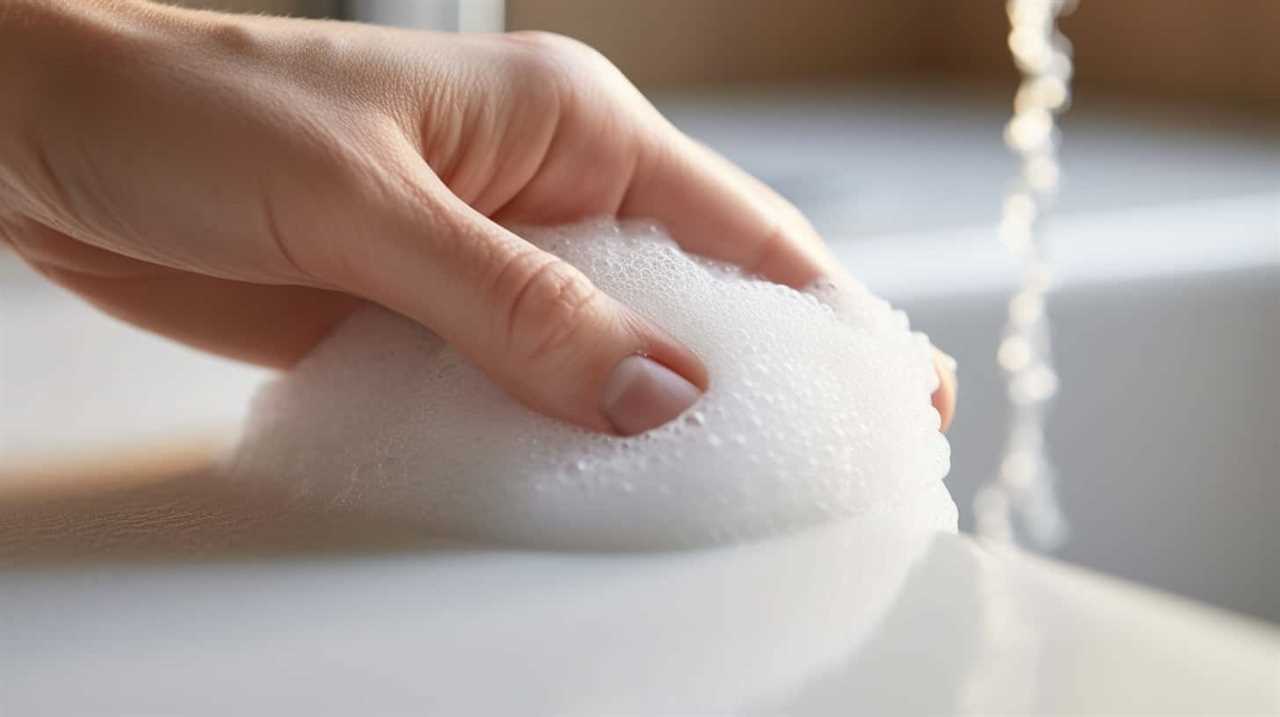
The trapway plays a vital role in clog prevention by incorporating specific mechanisms for clog detection and drain maintenance.
One such mechanism is the shape and size of the trapway itself. The trapway is designed to have a gradual slope and a larger diameter, allowing for efficient water and waste flow. This design minimizes the chances of clogs by preventing solid debris from getting stuck or accumulating in the drain.
Additionally, some modern toilets are equipped with advanced features like power-assisted flushing or pressure-assisted flushing systems. These systems use increased water pressure or forced air to propel waste through the trapway, further reducing the risk of clogs.
Regular drain maintenance is also crucial in preventing clogs. Periodic cleaning and inspection of the trapway can help identify and remove any potential obstructions before they become major issues.

The Role of Air Pressure in Flushing
We rely on air pressure to facilitate the flushing process. Here’s how it works:
- Air pressure variations: When we activate the flush, water is released from the tank into the bowl. As the water fills the bowl, it displaces the air inside the drainpipe. This increase in water level and decrease in air volume creates a difference in pressure.
- Impact of water level: As the water continues to fill the bowl, it reaches a certain level. At this point, the pressure difference becomes significant enough to overcome the resistance in the trap and the waste pipe. The high-pressure water pushes the waste and any clogs through the drainpipe.
- Siphoning action: The force of the water rushing down the drain creates a siphoning action, further aiding in clearing the waste. This action helps to ensure a complete evacuation of the bowl’s contents.
Understanding the role of air pressure in flushing helps us appreciate the engineering behind toilet systems and their efficient waste removal capabilities.
The Importance of Proper Ventilation
Proper ventilation is crucial for a well-functioning toilet flush drain.
Firstly, it ensures proper airflow, helping to eliminate unpleasant odors from the bathroom.

Secondly, it plays a key role in preventing plumbing issues such as clogs and backups, as adequate ventilation helps to maintain the right pressure balance in the system.
Lastly, proper ventilation contributes to health and safety by reducing the risk of harmful gases, such as methane, being trapped in the bathroom.
Airflow and Odors
Although often overlooked, proper ventilation plays a crucial role in maintaining airflow and minimizing odors in toilet flush drains. Here are three reasons why airflow control and odor elimination are important in toilet flush drains:
- Prevention of foul odors: Proper ventilation helps to remove gases and unpleasant odors from the toilet flush drain system. Without adequate airflow, these odors can linger and create an unpleasant environment.
- Reduction of bacterial growth: Good ventilation promotes airflow, which helps to prevent the growth of bacteria and other microorganisms in the drain system. This reduces the risk of contamination and potential health hazards.
- Maintenance of optimal performance: Effective airflow control ensures that the toilet flush drain system functions properly. It helps to prevent blockages and clogs, allowing for smooth and efficient drainage.
Preventing Plumbing Issues
To prevent plumbing issues, it is crucial to ensure proper ventilation in the toilet flush drain system. Proper ventilation plays a significant role in preventing leaks and maintaining water efficiency. By allowing for the proper flow of air, the ventilation system helps to regulate pressure within the drain pipes, preventing the buildup of excess pressure that can lead to leaks or bursts. It also helps to remove any unwanted odors and gases from the plumbing system, ensuring a clean and fresh environment.

Here is a table outlining the benefits of proper ventilation in the toilet flush drain system:
| Benefits of Proper Ventilation |
|---|
| Prevents leaks |
| Maintains water efficiency |
| Regulates pressure |
| Removes unwanted odors |
| Promotes a clean environment |
Health and Safety Benefits
Maintaining proper ventilation in the toilet flush drain system offers significant health and safety benefits. Here are three reasons why proper ventilation is crucial:
- Prevention of harmful gases: Adequate ventilation helps remove unpleasant odors and prevents the buildup of potentially harmful gases such as methane and hydrogen sulfide. These gases can be released during the decomposition of waste in the drain system, posing health risks if inhaled.
- Reduced risk of mold and mildew: Proper ventilation helps control humidity levels in the bathroom, reducing the chances of mold and mildew growth. Mold and mildew can trigger allergies and respiratory problems, especially in individuals with preexisting conditions.
- Improved indoor air quality: Ventilation helps remove airborne particles and contaminants, ensuring better air quality inside the bathroom. This is particularly important for individuals with respiratory issues or sensitivities to allergens.
Troubleshooting Common Flush Drain Issues
We often encounter several common issues when troubleshooting flush drain problems in our toilets. It’s important to have a good understanding of these issues and how to address them effectively.
One common problem is a clogged drain, which can be caused by a buildup of debris or foreign objects. To resolve this issue, a plunger or plumbing snake can be used to clear the blockage.
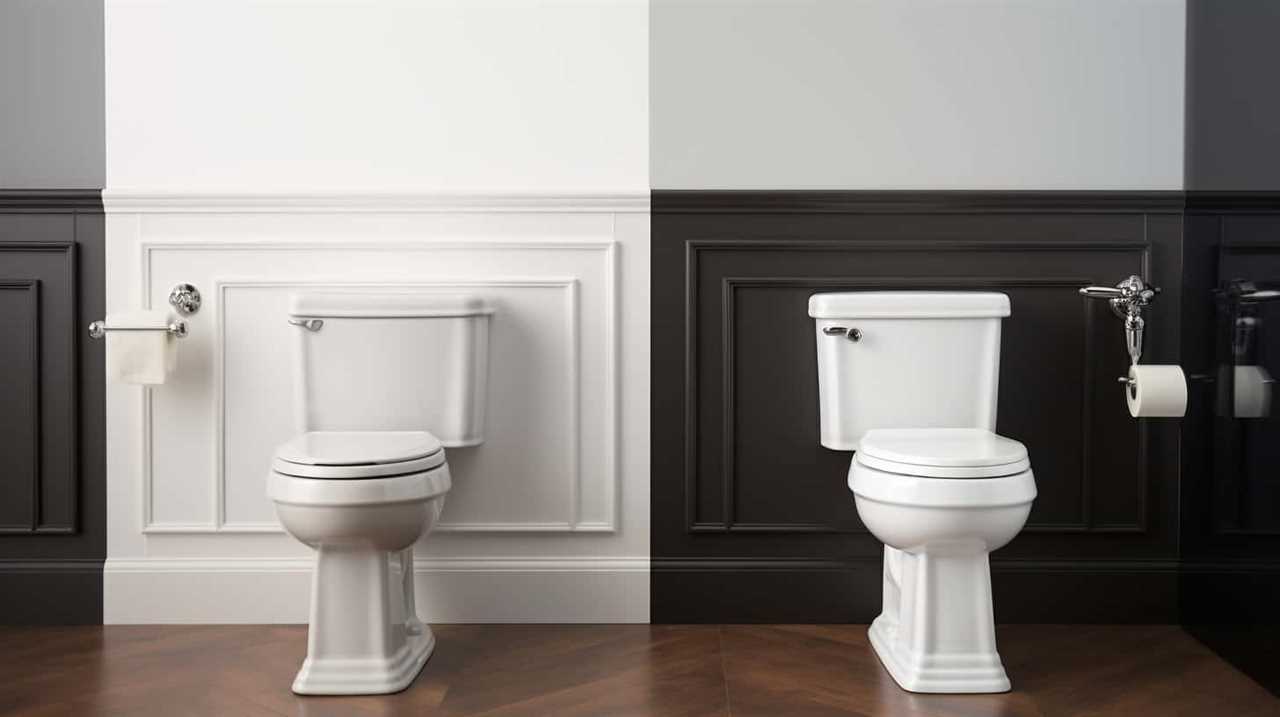
Another common issue is a weak flush, which may be caused by a problem with the flapper or the water level in the tank. Adjusting the water level or replacing the flapper can help resolve this problem.
Regular maintenance techniques such as keeping the drain clean and checking for any leaks can also prevent potential issues.
Frequently Asked Questions
How Do I Know if My Toilet Flush Drain Is Functioning Properly?
To determine if our toilet flush drain is functioning properly, we look for signs of malfunction. This includes checking for clogs, leaks, and slow drainage. Regular maintenance and proper toilet flush drain installation are crucial for optimal performance.
Can I Use Any Type of Toilet Paper With My Toilet Flush Drain?
Yes, we can use any type of toilet paper with our toilet flush drain. However, to be more eco-friendly, we recommend using biodegradable or recycled toilet paper as alternatives for proper toilet paper usage.

What Should I Do if My Toilet Flush Drain Is Constantly Clogged?
If our toilet flush drain is constantly clogged, we must address the issue promptly. Signs of a clogged drain include slow flushing and water backup. Unclogging methods such as using a plunger or drain cleaner can be effective solutions.
How Often Should I Clean or Maintain My Toilet Flush Drain?
We clean and maintain our toilet flush drain regularly to prevent clogs and ensure proper functioning. Signs of a dirty drain include slow flushing, gurgling sounds, and unpleasant odors. Regular maintenance frequency depends on usage and household size.
Are There Any Eco-Friendly Options for Toilet Flush Drains?
There are eco-friendly flush options available for toilet flush drains. Water-saving toilets provide benefits such as reducing water consumption and minimizing environmental impact. These options are ideal for individuals seeking sustainable solutions for their bathroom.
Conclusion
In conclusion, the toilet flush drain is a marvel of engineering, seamlessly combining water flow, gravity, and various components to ensure a clean and efficient flush.

From the flapper valve’s precise timing to the trapway’s clog prevention, every element plays a crucial role.
And let’s not forget the importance of proper ventilation, keeping odors at bay.
So next time you flush, marvel at the intricate dance of air pressure and water, creating a symphony of cleanliness in your bathroom.
